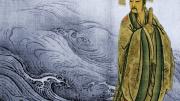One of the oldest foundational stories in Chinese mythology recalls the Great Flood: a massive cataclysm in the upper Yellow River valley that persisted for decades. Early historical texts describe “endless” water washing over hilltops and rising to the heavens. Survivors left their homes to seek shelter in the high mountains. Finally, a legendary hero, Yu the Great, tamed the flood by dredging channels to drain it away. This feat took years, and it earned him the divine mandate to establish the Xia dynasty, the first in Chinese history, marking the beginning of Chinese civilization.
Already ancient by the time it was written down in about 1,000 B.C.E., the story of the Great Flood was accepted as truth for more than 2,500 years. But a century ago, scholars began challenging it, questioning whether any real historical disaster lay behind the legend. Some wondered if the Xia dynasty itself was pure myth too, cooked up to justify the centralized rule and political succession of the country’s emperors. Archaeologists began searching for evidence that the flood—and the dynasty—had really existed.
They may have found it. A team of researchers including Ofer Bar-Yosef, MacCurdy professor emeritus of prehistoric archaeology, and his one-time student David Cohen ’86, Ph.D. ’01, now an archaeologist at National Taiwan University in Taipei, today published a paper in Science offering geological evidence, perhaps, of the Great Flood. Analyzing distinctive sediments deposited along the Yellow River, the researchers pieced together the sequence of events that unfolded almost 4,000 years ago. First, an earthquake in what is now Qinghai Province triggered a landslide that dammed the Yellow River where it flows through the Jishi Gorge, creating a lake that swelled to as deep as 130 meters. Then, six to nine months later, that landslide dam burst (most likely when the water rose too high), sending the flood rushing downstream, destroying everything in its path.
The location of the dam—and the researchers’ excavation—is some 2,500 kilometers from the site where Emperor Yu is supposed to have calmed the flood and established his dynasty, but Cohen, an expert on the history and archaeology of Bronze Age China, told reporters in a telephone press conference Wednesday that the floodwaters could easily have surged all that way, and to devastating effect. “This is the first time a flood of a scale large enough to account for [the Great Flood] has been found,” he said. “The outburst flood could have caused social disruptions downstream for years.”
The date also seems to fit. Using radiocarbon dating from charcoal deposits in the sediment and, with even more accuracy, the skeletons of three children who died when their houses collapsed in the initial earthquake, the researchers, led by Peking University’s Quinglong Wu, placed the flood at about 1920 B.C.E., which is 200 years later than the Xia Dynasty was long thought to have begun. That date, Cohen said, also roughly coincides with a critical turning point in Chinese civilization: the start of the Bronze Age and the appearance of the first state-level urban society, when bronze ritual weapons and other hallmarks of the early Chinese state began to emerge. According to history and legend, that turning point hinged on the flood. By dredging and guiding the waters back into their channels—an effort that would likely have required a large number of people—Yu “brings order out of chaos,” Cohen said. “He defines the land….He is establishing the political order and the ideologies of leadership.”
Absent any inscriptions or archaeological records from the Xia dynasty—and records from that early era are unlikely to be found, Cohen said—the geological data offer, if not definitive proof, at least “a tantalizing hint” that the dynasty really did exist.
Bar-Yosef, whose archaeological research has taken him to digs in Egypt, Turkey, the Czech Republic, the Republic of Georgia, and his native Israel, has worked in China for almost 20 years, studying the late Paleolithic era and the beginning of agriculture. Calling his own involvement in this flood study “accidental”—he was invited to join by researchers he’d collaborated with before—Bar-Yosef says the tug for archaeologists trying to unravel origin stories like the Great Flood is understandably strong. “It makes sense,” he explains. “We are constantly searching for archaeological evidence for events which are mentioned in our holy scriptures, whether they are Chinese or Jewish or Christian, and so on, and certain things in archaeology that we couldn’t discover in the past, we do discover them today.”









